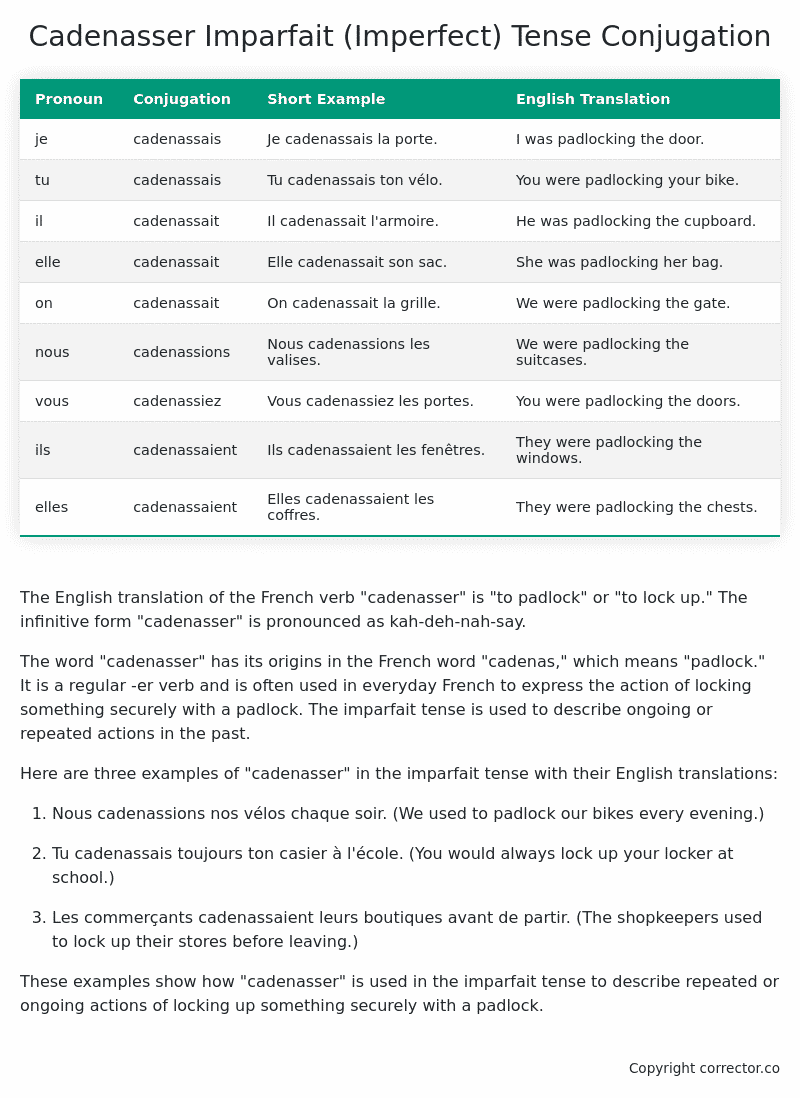Imparfait (Imperfect) Tense Conjugation of the French Verb cadenasser
Introduction to the verb cadenasser
The English translation of the French verb “cadenasser” is “to padlock” or “to lock up.” The infinitive form “cadenasser” is pronounced as kah-deh-nah-say.
The word “cadenasser” has its origins in the French word “cadenas,” which means “padlock.” It is a regular -er verb and is often used in everyday French to express the action of locking something securely with a padlock. The imparfait tense is used to describe ongoing or repeated actions in the past.
Here are three examples of “cadenasser” in the imparfait tense with their English translations:
-
Nous cadenassions nos vélos chaque soir.
(We used to padlock our bikes every evening.) -
Tu cadenassais toujours ton casier à l’école.
(You would always lock up your locker at school.) -
Les commerçants cadenassaient leurs boutiques avant de partir.
(The shopkeepers used to lock up their stores before leaving.)
These examples show how “cadenasser” is used in the imparfait tense to describe repeated or ongoing actions of locking up something securely with a padlock.
Table of the Imparfait (Imperfect) Tense Conjugation of cadenasser
| Pronoun | Conjugation | Short Example | English Translation |
|---|---|---|---|
| je | cadenassais | Je cadenassais la porte. | I was padlocking the door. |
| tu | cadenassais | Tu cadenassais ton vélo. | You were padlocking your bike. |
| il | cadenassait | Il cadenassait l’armoire. | He was padlocking the cupboard. |
| elle | cadenassait | Elle cadenassait son sac. | She was padlocking her bag. |
| on | cadenassait | On cadenassait la grille. | We were padlocking the gate. |
| nous | cadenassions | Nous cadenassions les valises. | We were padlocking the suitcases. |
| vous | cadenassiez | Vous cadenassiez les portes. | You were padlocking the doors. |
| ils | cadenassaient | Ils cadenassaient les fenêtres. | They were padlocking the windows. |
| elles | cadenassaient | Elles cadenassaient les coffres. | They were padlocking the chests. |
Other Conjugations for Cadenasser.
Le Present (Present Tense) Conjugation of the French Verb cadenasser
Imparfait (Imperfect) Tense Conjugation of the French Verb cadenasser (You’re reading it right now!)
Passé Simple (Simple Past) Tense Conjugation of the French Verb cadenasser
Passé Composé (Present Perfect) Tense Conjugation of the French Verb cadenasser
Futur Simple (Simple Future) Tense Conjugation of the French Verb cadenasser
Futur Proche (Near Future) Tense Conjugation of the French Verb cadenasser
Plus-que-parfait (Pluperfect) Tense Conjugation of the French Verb cadenasser
Passé Antérieur (Past Anterior) Tense Conjugation of the French Verb cadenasser
Futur Antérieur (Future Anterior) Tense Conjugation of the French Verb cadenasser
Subjonctif Présent (Subjunctive Present) Tense Conjugation of the French Verb cadenasser
Subjonctif Passé (Subjunctive Past) Tense Conjugation of the French Verb cadenasser
Subjonctif Imparfait (Subjunctive Imperfect) Tense Conjugation of the French Verb cadenasser
Subjonctif Plus-que-parfait (Subjunctive Pluperfect) Tense Conjugation of the French Verb cadenasser
Conditionnel Présent (Conditional Present) Tense Conjugation of the French Verb cadenasser
Conditionnel Passé (Conditional Past) Tense Conjugation of the French Verb cadenasser
Conditionnel Passé II (Conditional Past II) Tense Conjugation of the French Verb cadenasser
L’impératif Présent (Imperative Present) Tense Conjugation of the French Verb cadenasser
L’impératif Passé (Imperative Past) Tense Conjugation of the French Verb cadenasser
L’infinitif Présent (Infinitive Present) Tense Conjugation of the French Verb cadenasser
L’infinitif Passé (Infinitive Past) Tense Conjugation of the French Verb cadenasser
Le Participe Présent (Present Participle) Tense Conjugation of the French Verb cadenasser
Le Participe Passé (Past Participle) Tense Conjugation of the French Verb cadenasser
Struggling with French verbs or the language in general? Why not use our free French Grammar Checker – no registration required!
Get a FREE Download Study Sheet of this Conjugation 🔥
Simply right click the image below, click “save image” and get your free reference for the cadenasser imparfait tense conjugation!

Cadenasser – About the French Imparfait Tense
NOTE: To take a deep dive into all the French tenses then see our article on Mastering French Tense Conjugation.
Formation of the Imparfait Tense
For regular -er verbs:
For regular -ir verbs
For regular -re verbs
Common Everyday Usage Patterns
Description of Past Habits
Background Information
Mental and Emotional States
It’s employed to express emotions, thoughts, or physical sensations in the past. For example: “J’étais content quand il est arrivé.” (I was happy when he arrived.)
Ongoing Actions
Points to Note About the Imparfait Tense
Passé Composé vs. Imparfait
Conditional
Si Clauses
Narration
I hope you enjoyed this article on the verb cadenasser. Still in a learning mood? Check out another TOTALLY random French verb imparfait conjugation!


